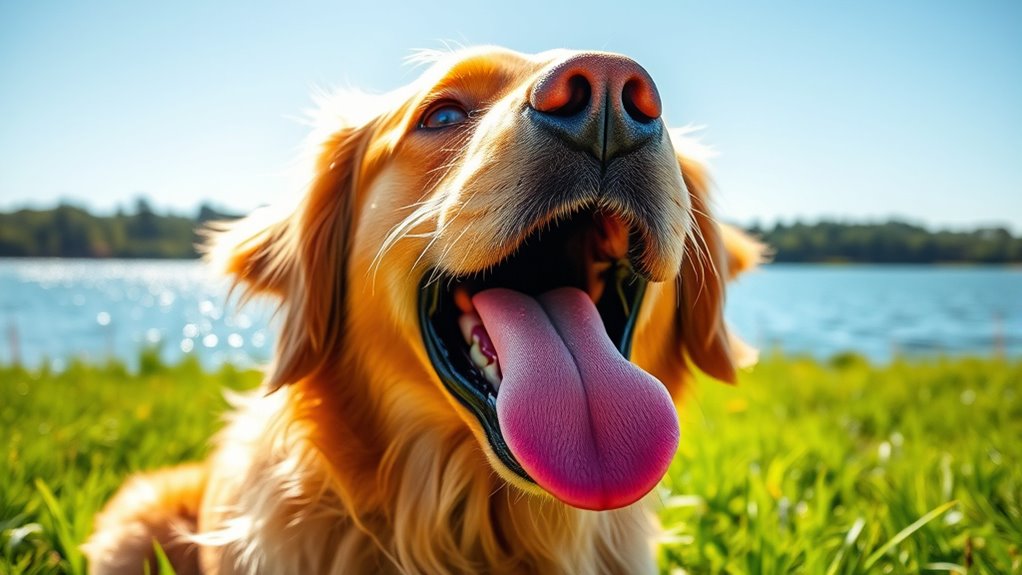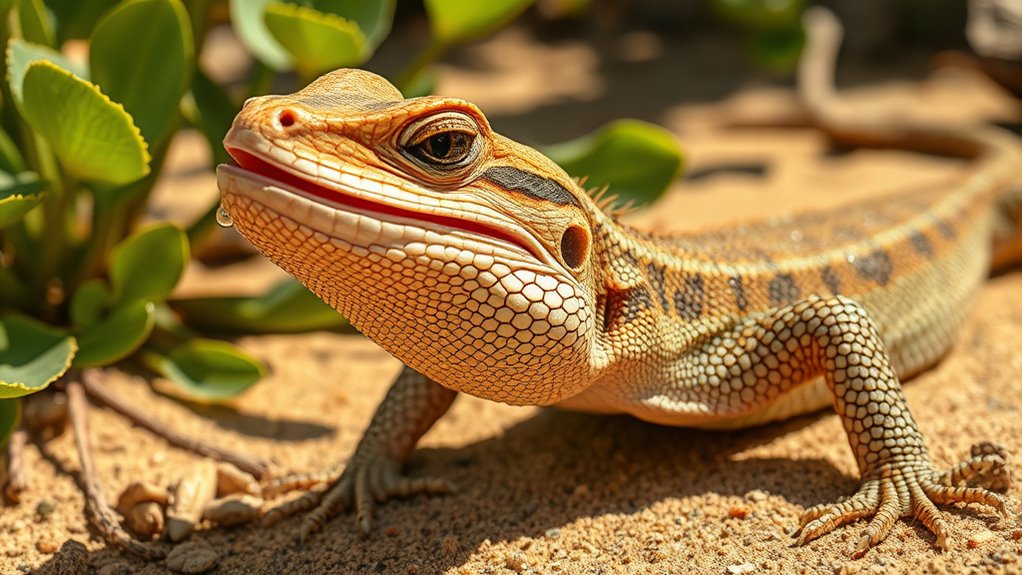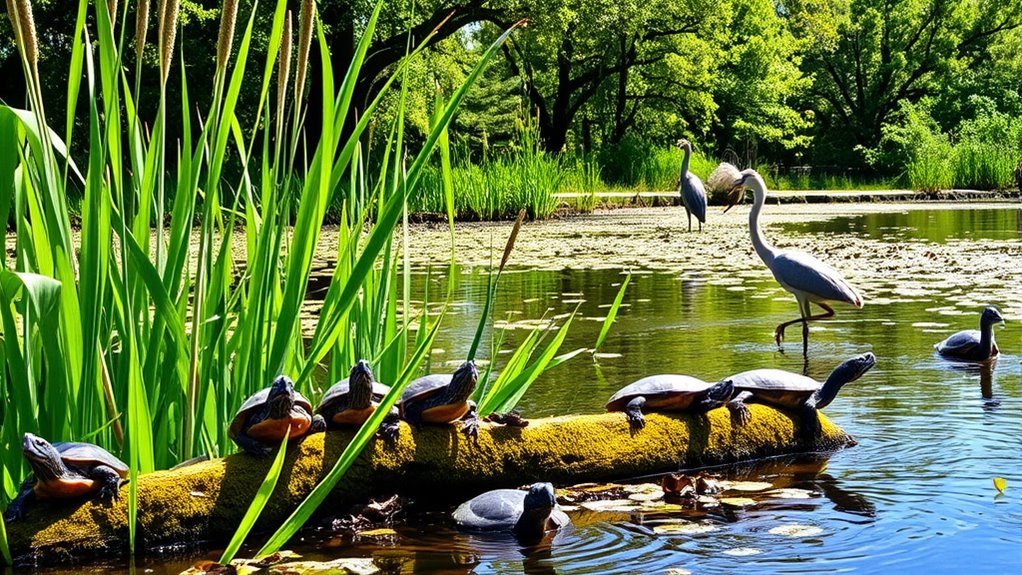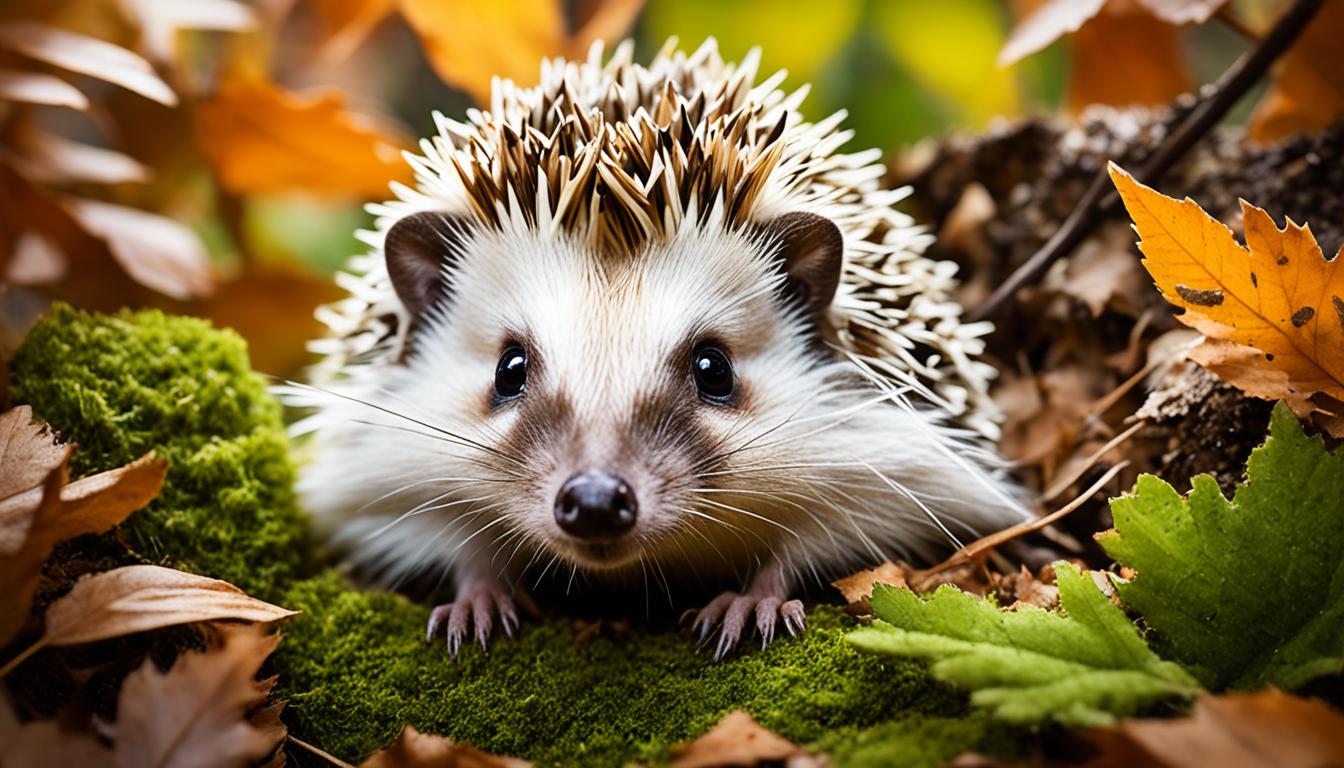Animals have developed smart ways to beat the summer heat. They pant to increase evaporative cooling, while birds flutter their throat pouches for extra relief. Many creatures seek shade to escape the sun, and waterfowl cool off by swimming. Reptiles, like turtles, burrow into cool ground to stay comfortable. By watching these behaviors, you can discover more about how different species adapt to warm weather and survive effectively in their environments.
Key Takeaways
- Mammals like deer and raccoons use panting to increase evaporative heat loss and cool their bodies during hot weather.
- Birds perform gular fluttering, rapidly moving their throat pouch to enhance evaporative cooling and maintain body temperature.
- Many wild animals instinctively seek shade to escape heat, conserving energy and avoiding overheating.
- Waterfowl swim or stand in water, using blood circulation in their feet to dissipate heat effectively.
- Animals adjust their activity patterns, being more active during cooler evening hours to avoid peak heat exposure.
Panting: A Mammal's Best Friend

When summer heat hits, mammals like deer, raccoons, and foxes turn to panting as their go-to method for cooling down.
This behavior ramps up evaporative heat loss from their respiratory tract, allowing them to expel warm air and inhale cooler air. You can see how this helps reduce their core body temperature in hot weather.
The moisture in their respiratory systems plays an essential role, evaporating to dissipate heat effectively. Unlike sweating, which isn't efficient for many mammals, panting is a rapid response to heat stress, especially when they're active.
As their respiratory rate increases, they also need more oxygen, making panting not just a cooling mechanism but a significant adaptation for survival in extreme heat.
Cooling Through Gular Fluttering

When it comes to staying cool, birds have a unique trick called gular fluttering.
By rapidly moving their throat pouch, they enhance evaporative cooling and regulate their body temperature, especially in extreme heat.
You'll often see this fascinating technique in action with species like the great blue heron.
Mechanism of Gular Fluttering
Gular fluttering serves as a remarkable cooling mechanism for birds, particularly evident in species like the great blue heron. By rapidly contracting and expanding their throat pouch, birds increase evaporation, which helps lower their body temperature. This behavior is especially essential in hot environments, providing an alternative to panting and reducing the risk of overheating. Observing gular fluttering in birds during high heat or humidity highlights its importance as an adaptive thermoregulatory strategy.
| Mechanism | Effect | Benefit |
|---|---|---|
| Rapid movement | Increases evaporation | Lowers body temperature |
| Throat pouch | Enhances cooling | Prevents overheating |
| Adaptive strategy | Survives heat | Guarantees survival |
Species Utilizing This Technique
Many bird species have adapted to withstand extreme heat by utilizing gular fluttering as an efficient cooling technique. This behavior is especially evident in great blue herons, which rapidly move their throat muscles to create airflow, enhancing heat loss.
By increasing evaporative cooling from their throat area, these birds effectively lower their body temperature during scorching weather. Gular fluttering proves invaluable, allowing them to cope with high temperatures without relying solely on water or shade.
This technique is particularly beneficial during prolonged heat exposure, helping birds maintain their physiological performance and avoid overheating. Studies show that birds engaging in gular fluttering can markedly reduce their body temperature, which boosts their overall survival in hot environments.
Seeking Shade: The Smart Move

As temperatures soar during the summer, wild animals instinctively seek out shade to escape the heat and conserve energy. This behavior isn't just smart; it's essential for survival.
Here are a few ways animals utilize shade:
- Deer and raccoons find cool spots to avoid overheating and maintain their energy levels.
- Box turtles burrow into leaves or soil, creating a cooler microenvironment to regulate their body temperature.
- Bison and foxes lie in shaded areas or roll in dirt, cooling off while minimizing insect irritation.
The Role of Water in Temperature Regulation

While summer heat can be relentless, animals have developed ingenious ways to stay cool, and water plays an essential role in their temperature regulation.
Waterfowl like ducks and geese swim or stand in water to keep their bodies cool. Their blood circulation through the feet helps dissipate heat, allowing them to maintain comfort even on hot days.
Fish often seek deeper, cooler waters or shaded areas to escape the heat, as these spots typically offer lower temperatures than the surrounding air.
Common loons demonstrate that swimming is an effective cooling strategy, highlighting the significance of aquatic environments.
Wetlands create critical cooling habitats for various species, including killdeer, who rely on these cooler microclimates to thrive in warm weather.
Burrowing and Hiding: Reptile Strategies

Reptiles have developed effective strategies to escape the sweltering summer heat, often seeking refuge beneath logs, rocks, or in burrows. This behavior helps them minimize heat stress and maintain their physiological balance.
Here's how they do it:
- Burrowing: Box turtles dig into leaves or soil, using the earth's insulation to regulate their body temperature.
- Microhabitats: Some snakes utilize underground burrows made by other animals, finding cool spots during extreme heat.
- Timing: Lizards stay inactive during the hottest parts of the day, emerging in the cooler morning or evening to hunt and bask.
Behavioral Changes in Hot Weather

When the summer heat intensifies, many animals instinctively alter their behavior to stay cool and safe. You might notice wild animals seeking shade during the hottest parts of the day, demonstrating their natural instinct to regulate body temperature.
Species like deer, raccoons, and foxes often pant to aid in evaporative heat loss, helping them cope with the warmth. American bison lie down in dirt to cool off and minimize insect irritation.
Box turtles dig into leaves and soil during extreme heat, using the cooler ground to maintain comfort. Plus, numerous animals become more active in the cooler evening hours, skillfully adjusting their routines to avoid the peak heat of the day.
The Importance of Larger Ears

How do animals like white-tailed deer manage to stay cool during scorching summer days? One key factor is their larger ears. These ears aren't just for hearing; they play an essential role in regulating body temperature.
Here's how:
- Heat Dissipation: Large ears contain a network of blood vessels that help release heat when blood circulates through them.
- Enhanced Heat Exchange: The increased surface area allows for more effective heat exchange, helping these animals cool down.
- Evolutionary Advantage: Species like the fennec fox have evolved disproportionately large ears to release body heat while improving their hearing.
In hot climates, larger ears aren't just a trait; they're a survival mechanism, helping animals maintain a lower internal body temperature.
Swimming as a Cooling Technique

Many animals, especially waterfowl, rely on swimming as an important cooling technique during the hot summer months. Ducks and geese often immerse themselves in water to regulate their body temperature, while common loons swim to access cooler water and manage heat.
Fish, too, seek deeper, shaded areas to escape the sweltering temperatures. Swimming not only cools aquatic birds like ospreys and bald eagles but also helps with their hunting, keeping them in thermally regulated zones.
Additionally, the blood vessels in the feet of waterfowl play a significant role in temperature regulation, allowing for efficient heat exchange as they swim. This natural behavior highlights how swimming serves as an essential strategy for many species to beat the summer heat.
Natural Cool Zones: Wetlands and Shaded Areas

As temperatures rise during the summer, wetlands and shaded areas become essential cool zones for various species. These natural habitats provide relief from the heat in several ways:
- Waterfowl like ducks and geese use wetland waters to regulate their body temperature.
- Fish often seek deeper waters or shaded spots to escape intolerable surface temperatures.
- Animals such as box turtles and snakes burrow into cool, moist soil or hide beneath logs to avoid extreme heat.
Additionally, wildlife like deer and bison rest in shaded areas during the hottest parts of the day, allowing them to lower their body temperatures.
Wetlands not only offer these cooling zones but also support a rich ecosystem, demonstrating how interconnected habitats are with animal behavior.
Lessons From Nature: Inspiring Human Cooling Strategies

Look to nature for clever ways to beat the heat.
By observing how animals cool themselves, you can find inspiration for creating your own revitalizing spaces.
From using water features to incorporating natural ventilation, there's plenty to learn from the animal kingdom.
Nature's Cooling Techniques
While humans often rely on air conditioning and fans to beat the summer heat, nature offers a wealth of innovative cooling techniques used by animals that can inspire our own strategies.
By observing how animals manage heat, you can adopt some clever methods to stay comfortable:
- Panting: Like white-tailed deer, use your breath to cool down. Rapid breathing helps regulate body temperature.
- Gular Fluttering: Birds like great blue herons use throat movements for evaporative cooling; try sipping cold water to achieve a similar effect.
- Seeking Water: Ducks and geese immerse themselves in water. You can take a revitalizing dip or even use a cool cloth to lower your body temperature.
Integrating these techniques into your routine can help you stay cool naturally this summer! Additionally, maintaining high vibrational energy through relaxation techniques can further enhance your comfort in the heat.
Behavioral Adaptations Observed
Observing how animals adapt their behavior to cope with heat reveals valuable lessons we can apply to our own lives. Many wild animals, like deer and raccoons, pant to cool down, much like using fans or air conditioning.
Birds such as great blue herons employ gular fluttering for enhanced air circulation, suggesting we should increase airflow in our spaces.
American bison roll in dirt to cool off and deter insects, inspiring us to use natural materials for comfort and protection.
Species like box turtles and snakes retreat to shaded areas, reminding us to seek shelter during hot weather.
Finally, waterfowl cool off by swimming, highlighting the benefits of incorporating water features or staying hydrated in our environments. Additionally, some animals consume omega-3 fatty acids to help regulate their body temperature, indicating that incorporating nutrient-rich foods can support our own cooling strategies.
Water as Relief
Water is an essential resource for animals seeking relief from the summer heat, and their strategies can inspire us to find our own cooling solutions.
Here are a few lessons we can learn:
- Waterfowl like ducks and geese cool down by swimming or standing in water, benefiting from its lower temperature.
- Fish escape the heat by diving into deeper waters or finding shaded spots, reminding us of the importance of aquatic environments.
- Common loons employ swimming to regulate their body temperature, showcasing water's role in thermoregulation.
Frequently Asked Questions
How Do Animals Keep Cool in the Summer?
When you think about how animals keep cool in the summer, consider their various strategies. Some animals, like deer and foxes, pant to increase evaporative cooling.
Birds might flutter their throats or seek water to regulate their temperature. Others, like turtles and snakes, find shade or burrows to escape the heat.
Meanwhile, bison roll in dirt or lie down to cool off while also managing pesky insects. Each one has its unique way to beat the heat!
How Do Animals Not Overheat?
Just like a flame flickering in the wind, animals instinctively find ways to avoid overheating.
You might notice how they pant or flutter their gulars, letting the coolness of evaporation wash over them. Swimming in water or burrowing into the earth provides relief from the oppressive heat.
Each behavior symbolizes their resilience, a reminder that adaptation is key in the dance of survival, helping them thrive even when temperatures soar.
How Do Animals Survive in Extreme Heat?
When it comes to surviving in extreme heat, animals employ various strategies to cope. You might notice mammals panting or using shade to escape the sun.
Birds often flutter their throats to cool down, while reptiles burrow into the ground or hide under logs.
Even aquatic birds like ducks seek water for relief. By adapting their behaviors, these creatures effectively manage their body temperature and guarantee their survival during scorching conditions.
What Are the Cooling Mechanisms of Animals?
Did you know that some animals can lose up to 30% of their body weight through sweating and panting? Animals use various cooling mechanisms to regulate their temperature.
For instance, you might notice how dogs pant to evaporate moisture and cool down. Birds like herons flutter their throats rapidly for similar reasons.
Meanwhile, mammals like deer use their large ears to dissipate heat, while reptiles seek shade or burrow to escape the heat.
Conclusion
As you soak in the summer sun, remember the clever ways animals beat the heat. From panting like a dog to seeking shade like a savvy cat, nature's got some cool tricks up its sleeve. So, whether you're diving into a pool or chilling in a shady spot, take a cue from our furry and scaly friends. Just like a wise old owl once said, staying cool is all about knowing where to find your breeze!










